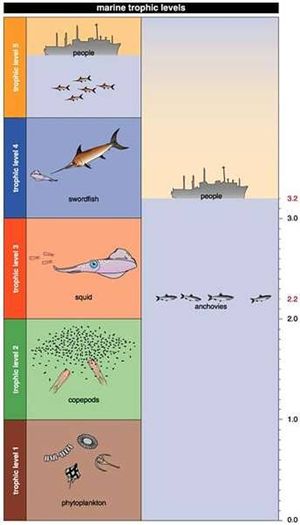Difference between revisions of "Trophic level - a marine example"
Dronkers J (talk | contribs) |
|||
| (11 intermediate revisions by 3 users not shown) | |||
| Line 1: | Line 1: | ||
| − | Throphic levels are the layers that make up food webs, wherein animals are ranked according to how many steps they are above the primary producers at the base of the food web. Microscopic plants at the bottom are assigned a throphic level of 1, while the herbivores and detritivors that feed on the plants and detritus make up trophic level 2. Higher order carnivores such as most marine mammals, are assigned trophic levels ranging from 3 to 5. Animals that feed from more than one trophic level have non-integer trophic levels. Thus knowing what an animal eats is all that is needed to calculate its trophic level.<ref name="Pauly1998">Pauly, D.; Christenen, V.; Dalsgaard, J.; Froese, R.; Torres, F. Jr. (1998). Fishing Down Marine Food Webs. ''Science'' 279: 860-863.</ref> | + | {{ |
| + | Definition|title=Trophic level | ||
| + | |definition=Throphic levels are the layers that make up [[Food web|food webs]], wherein animals are ranked according to how many steps they are above the primary producers at the base of the food web. Microscopic plants at the bottom are assigned a throphic level of 1, while the herbivores and detritivors that feed on the plants and detritus make up trophic level 2. Higher order carnivores such as most marine mammals, are assigned trophic levels ranging from 3 to 5. Animals that feed from more than one trophic level have non-integer trophic levels. Thus knowing what an animal eats is all that is needed to calculate its trophic level.<ref name="Pauly1998">Pauly, D.; Christenen, V.; Dalsgaard, J.; Froese, R.; Torres, F. Jr. (1998). Fishing Down Marine Food Webs. ''Science'' 279: 860-863. http://www.seafriends.org.nz/issues/fishing/pauly1.htm</ref>}} | ||
| − | [[Image:trophic level.jpg| | + | [[Image:trophic level.jpg|right|300px]]. |
| + | |||
| + | ==Notes<ref>Roberts, Edward in: http://www.seafriends.org.nz/issues/fishing/pauly0.htm</ref>== | ||
| + | |||
| + | Trophic levels were initially defined to include only discrete steps (left of diagram). Organic detritus and microscopic plants (phytoplankton) occupy the first trophic level. Tiny zooplankton, which feed on phytoplankton, reside at the second level. Creatures that eat zooplankton sit at the third level, and so forth. But many marine creatures feed from multiple trophic levels and so could not be fit into this classic scheme. Thus the modern approach allows the assignment of trophic level to span a continuum rather than forcing it to take on integral values. Marine biologists would, for example, assign the anchovy (''Engraulis encrasicolus'') which supplements its main diet of phytoplankton with some zooplankton, to a trophic level of about 2.2; people fishing for anchovies (and eating a diet of only these small fish) would then be assigned a trophic level of 3.2 (right). | ||
| + | This definition uses some of the examples associated with the [[effects of fisheries on marine biodiversity]]. | ||
| + | |||
| + | There is a detailed discussion of this subject under the title "Trophic dynamics" in the Wikipedia see http://en.wikipedia.org/wiki/Trophic_level) | ||
| + | |||
| + | |||
| + | ==Related articles== | ||
| + | :[[Trophic cascade]] | ||
| Line 8: | Line 21: | ||
| − | [[Category: | + | [[Category:Coastal and marine ecosystems]] |
Latest revision as of 22:04, 27 December 2020
Definition of Trophic level:
Throphic levels are the layers that make up food webs, wherein animals are ranked according to how many steps they are above the primary producers at the base of the food web. Microscopic plants at the bottom are assigned a throphic level of 1, while the herbivores and detritivors that feed on the plants and detritus make up trophic level 2. Higher order carnivores such as most marine mammals, are assigned trophic levels ranging from 3 to 5. Animals that feed from more than one trophic level have non-integer trophic levels. Thus knowing what an animal eats is all that is needed to calculate its trophic level.[1]
This is the common definition for Trophic level, other definitions can be discussed in the article
|
Notes[2]
Trophic levels were initially defined to include only discrete steps (left of diagram). Organic detritus and microscopic plants (phytoplankton) occupy the first trophic level. Tiny zooplankton, which feed on phytoplankton, reside at the second level. Creatures that eat zooplankton sit at the third level, and so forth. But many marine creatures feed from multiple trophic levels and so could not be fit into this classic scheme. Thus the modern approach allows the assignment of trophic level to span a continuum rather than forcing it to take on integral values. Marine biologists would, for example, assign the anchovy (Engraulis encrasicolus) which supplements its main diet of phytoplankton with some zooplankton, to a trophic level of about 2.2; people fishing for anchovies (and eating a diet of only these small fish) would then be assigned a trophic level of 3.2 (right). This definition uses some of the examples associated with the effects of fisheries on marine biodiversity.
There is a detailed discussion of this subject under the title "Trophic dynamics" in the Wikipedia see http://en.wikipedia.org/wiki/Trophic_level)
Related articles
References
- ↑ Pauly, D.; Christenen, V.; Dalsgaard, J.; Froese, R.; Torres, F. Jr. (1998). Fishing Down Marine Food Webs. Science 279: 860-863. http://www.seafriends.org.nz/issues/fishing/pauly1.htm
- ↑ Roberts, Edward in: http://www.seafriends.org.nz/issues/fishing/pauly0.htm
